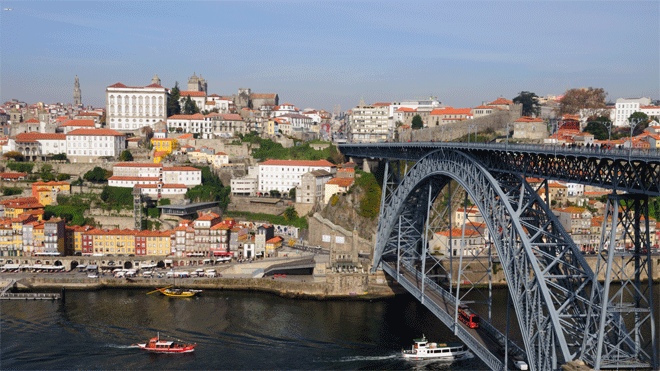We made a short stop at Porto, the second largest city in Portugal next to Lisbon. Since this is not in our official itinerary, we did not see much, except for the riverside quarter of Ribeira as we crossed the Ponte Luis I. This is the part of the city that lies along the banks of the Douro River.
Traditional boats floated at the quayside overlooked by colourful ancient houses and medieval streets, and lined by smoky bars and seafood restaurants. Across the river is Vila Nova de Gaia, where according to our guide, we could find the port wine cellars.
I felt like being teased. There I was, in a vibrant mercantile riverside city and instead of enjoying the scenery at an outdoor café with a glass of port for which it is known for, and sampling local dishes like their salted codfish (bacalhau) or tripe dish (tripas a moda do Porto) or that toast with layers of meat smothered with cheese and spicy sauce (Franceshinha), we were brought to a gas station-convenience store pit stop and I had to content myself with a regular cup of coffee.
However, I got a pleasant surprise in the form of freshly-baked Portuguese tarts and bright red, extra large, and very-juicy-looking cherries sold in nice, little baskets at a fair price. It seems that the gas station stops in most of Europe are several notches higher than their American and Canadian counterparts. Most offer high-quality coffee prepared by baristas served in ceramic cups and saucers instead of diluted coffee in paper cups. And instead of stale donuts, they had baked goods made from scratch. There was also a good-sized grocery section, a souvenir shop, and a corner market with freshly-picked local produce. I made a note to myself that gas station pit stops over here shouldn’t be bad.
Since we missed the getting the pastéis de Belém from the original pastry shop in Belém (Fábrica Pastéis de Belém, a family-run place that guards the ancient recipe from the Mosteiro dos Jerónimos), I was glad that I could still try a Portuguese tart. Our Tour Director was quick to clarify that we should refer to the ones we were having as pasteis de nata. The one from Belém, created in 1837 and whose exact recipe is kept secret, is the authentic one and the only custard that can be called pastéis de Belém, since the name is patented. All other custards around Portugal are simply, pasteis de nata.
One of my tour mates asked him why he didn't take us there. He said that they always have a long line-up and that we had to get going. Sigh. I guess I should go back to Lisbon for that. But he assured us that we could find very good pastéis de nata all over Portugal. The ones we got from the gas station pit stop were actually from a well-known local bakery that makes them from scratch.
These custard tarts are made of puff pastry, egg, milk, and sugar, and are blended with lemon and cinnamon. The piping hot crust was so buttery and flaky, and the creamy custard filling with caramelized sugar on top had the perfect dose of sweetness. It went well with my bica (Portuguese version of the espresso) and I finished off my snack with the juicy cherries.
We passed by the imposing Estádio do Dragão (Stadium of the Dragon), home of the FC Porto, the city’s football team on our drive north. Our Tour Director said that football is big in Portugal and that there is a strong rivalry between the Lisbon and the Porto teams, in the same way that the Madrid and Barcelona teams in Spain are competing neck-to-neck. He added that like the Catalans in Barcelona, the citizens of Porto hold themselves culturally apart from the rest of the country and football is one among many channels where they can express their independent pride.
I made a mental note to put Porto at the top of my list if I do go back to Portugal.
Photo Credits:
visitportugal.com, portugalinews.eu, abola.pt, notquitenigella.com













Comments